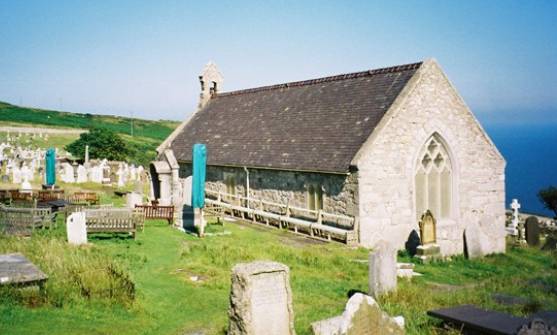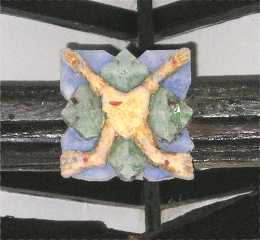
On
the northern side of the Great Orme at Llandudno, nestling in a
sheltered hollow, is
the
church of Saint Tudno with its churchyard and the adjacent town
cemetery, still
in regular use. This
little church, open daily during the season, was built in the 12th
century on a
Christian site dating from the 6th century and dedicated to the memory
of its
founder St. Tudno. He was one of the seven sons of
King
Seithenyn whose legendary kingdom in Cardigan Bay was submerged by
tidal
activity. Each son in reparation for their father's neglect, so it was
seen,
studied in St. Dunawd's college at Bangor Iscoed (Bangor on Dee, near
Chester) and went to an isolated part of Wales to preach the Christian
faith to the people.

Hardd
Havan Hedd – Beautiful
Haven of Peace
Later Tudno
established the Church on Cyngreawdr (the
great rock - the Great Orme). The
Ogof Llech (a small cave on the headland, difficult of access, but with
a clear spring of water) was Saint Tudno’s cell, from which he took the
faith of Christ to the local people. Saint Tudno’s Church is a monument
and a witness to the men and women of faith who through the ages and to
the present day brought the Peace of Christ to the people of Llandudno.
The Feast of
Saint Tudno is celebrated each year on 5th June. 'Y Gwylmabsant' or the
Patronal Festival was observed on the Great Orme annually on that date
early in the 19th century (recorded in the Cambrian Traveller's Guide
of 1813
and reported
in 'The Old Churches of Snowdonia' by Harold Hughes & Herbert
North, 1924 reprinted 1984).
Saint Tudno's ancient church (see photographs below) has been heavily
restored many times until nothing remains from Tudno’s day. The church,
built and rebuilt over many centuries, achieved its final
form in the 15th century. The roof
blew off during a fierce gale in January 1839 and it was not restored,
rather the Church authorities decided to build a new church on the
other side of the Orme in what is now Church Walks. The new church,
completed in 1840, was called Saint George's and the status of parish
church was transferred to it by Queen Victoria in November 1862. Until
then, St Tudno's had remained the parish church and a restoration
appeal in
1855 enabled the roof to be repaired and the church returned to use.
The medieval wall
paintings were all lost in the restorations of 1855, 1888 & 1906.
The
church has a few ancient features, the font dates from the 12th
century, and there are early sepulchral stones, otherwise most of the
furnishings, date from the restorations.
There is,
however, a remarkable medieval survival, a carved wooden roof boss high
above the
chancel step depicting the 'stigmata' or five wounds of Christ. This
stigmata emblem is an almost unique survival in Wales, only one other
is known in a Welsh church and it is preserved at Saint Hilary's Church
in the neighbouring parish of Llanrhos, where it is mounted on a wall
plaque together with three other roof bosses that are carved with the
traditional emblems of the evangelists Mark, Luke and John. There is
also in St. Tudno's an ancient beam (possibly part of the rood beam)
with a carved serpent upon it
forming a wall plate above the
north window in the chancel. A short portion of the original rood
screen (carved with a vine motif) is fixed to the west wall.

Saint Tudno's Church

The interior of Saint Tudno's Church with its
Chancel Screen (1888)

The ancient
Stigmata roof boss above
the chancel step depicting the five wounds of Christ

The 12th Century
Font

Early Stone
Coffin Lids

This small window
(the earliest surviving stone window in the church)
is unusually set in the north wall of the church, and tradition
claims
that it was used to provide a light for mariners
seeking to identify their
position on dark winter nights.

